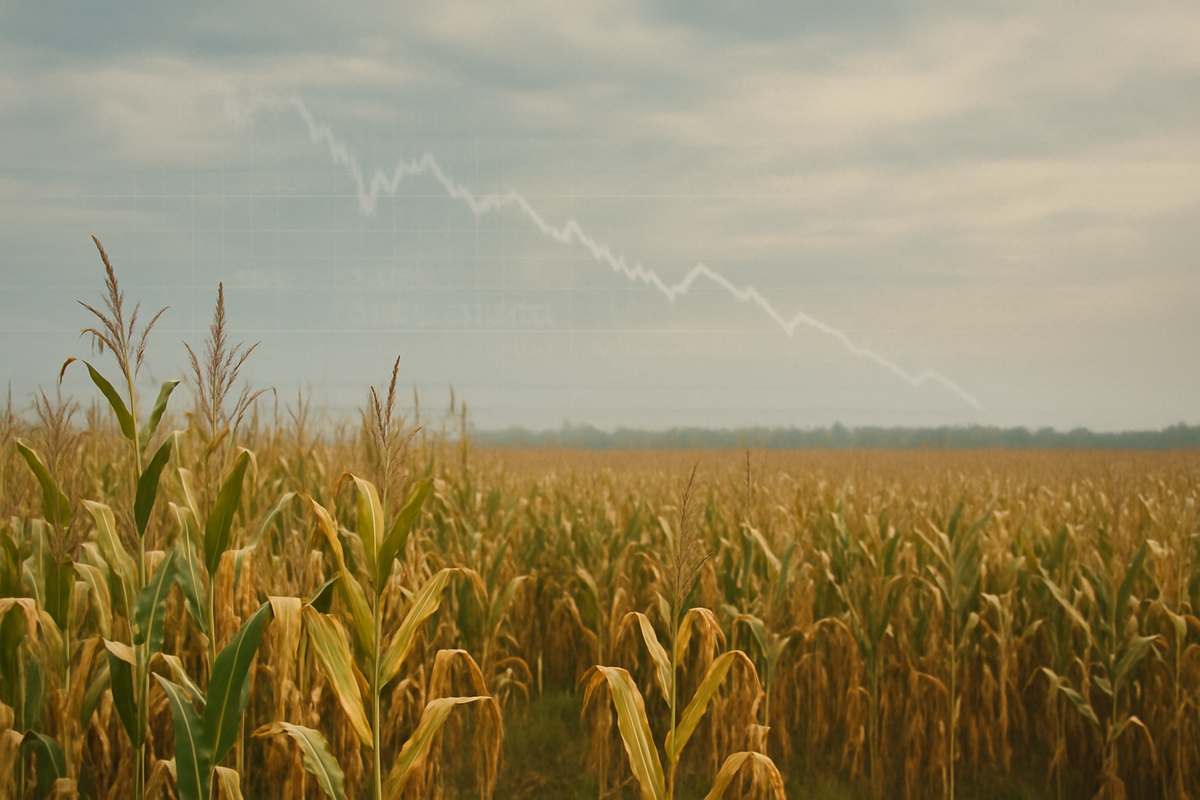Corn Futures Edge Lower Amidst Government Shutdown Uncertainty and Robust Harvest

Chicago, IL – October 9, 2025 – The corn market experienced a slight downturn today, October 9, 2025, with December 2025 corn futures (ZCZ5) registering a minor decline. This modest dip comes at a time of heightened market uncertainty, largely driven by an ongoing U.S. government shutdown that has halted crucial agricultural data releases. While the day's movement was fractional, it underscores a complex environment for one of the world's most vital commodities, where robust domestic production contends with an information vacuum and persistent financial pressures on farmers.
The immediate implications of this slight price decline are multifaceted. For traders and analysts, the absence of the highly anticipated World Agricultural Supply and Demand Estimates (WASDE) report, typically a cornerstone for market direction, creates a significant challenge. This "information vacuum" fosters volatility and makes accurate price forecasting and risk management exceedingly difficult. Meanwhile, for the agricultural sector, particularly farmers already grappling with elevated input costs, any downward pressure on prices adds to an already strained financial landscape.
Detailed Coverage: Navigating an Uncharted Market
Today’s trading saw December 2025 corn futures quoted around 421'6, reflecting a minor decline of approximately 0.06% to 0.22% from the previous day's close, settling near $4.21 per bushel. This movement, while small, is indicative of a market searching for direction amidst conflicting signals. It's important to contextualize these prices; current levels are significantly below the peak of around $7 per bushel observed in 2022, marking a broader downtrend for the grains sector, which has seen a 7% decline this year.
The timeline leading up to this moment is critical. The U.S. government shutdown, which commenced on October 1, 2025, immediately impacted the availability of key agricultural reports from the USDA, including the WASDE report scheduled for today. This has left market participants operating with incomplete information, increasing speculative activity and technical trading based on chart patterns rather than fundamental data. Key players involved include farmers, who are the primary producers; commodity traders and brokers, who facilitate market transactions; and large agricultural companies that process and distribute corn globally. Initial market reactions have been characterized by cautious trading and a lack of strong directional conviction, as players await the resumption of government services and the release of delayed data.
Despite the price dip, underlying fundamentals present a mixed picture. Favorable weather conditions across the Midwest and Great Plains have contributed to robust corn production and good crop quality, with 66% rated good to excellent. Such strong yields typically exert downward pressure on prices. Simultaneously, demand for ethanol continues to provide a foundational level of support for corn prices, with output reaching a monthly high of 1.071 million barrels per day in the week ending October 3. However, export competition from other major producers like Ukraine and France continues to challenge U.S. corn's competitiveness in global markets, while "tariff wars" have also shifted some trade dynamics, particularly with China sourcing soybeans from South America, which could indirectly impact U.S. corn export opportunities.
Corporate Fortunes: Who Wins and Who Loses?
The slight decline in corn prices, coupled with the broader market conditions, creates distinct winners and losers among public companies and stakeholders. On the winning side, companies that utilize corn as a primary input for their products stand to benefit from lower raw material costs. This includes food processing giants like General Mills (NYSE: GIS) and Kellanova (NYSE: K) (formerly Kellogg Company), which use corn in various cereals and snack foods. Similarly, ethanol producers such as Green Plains Inc. (NASDAQ: GPRE) and Valero Energy Corporation (NYSE: VLO), which operates significant ethanol production facilities, could see improved margins as their main feedstock becomes more affordable. Lower corn prices translate directly into reduced operational expenses, potentially boosting profitability.
Conversely, the primary losers in this scenario are the farmers themselves, who face the brunt of lower commodity prices while simultaneously battling persistently high input costs. Essentials like fuel, fertilizers, and seeds have seen substantial price increases since 2020, putting immense financial strain on agricultural operations. Reports indicate an increase in farm bankruptcies in the first two quarters of 2025, with some farmers reportedly selling corn below their cost of production. Publicly traded companies that supply these agricultural inputs, such as seed and chemical giant Corteva Agriscience (NYSE: CTVA) or farm equipment manufacturer Deere & Company (NYSE: DE), could face headwinds if farmers reduce spending due to tighter margins. Furthermore, large agricultural trading and processing firms like Archer-Daniels-Midland (NYSE: ADM) and Bunge Global SA (NYSE: BG), while diversified, could see impacts on their grain origination and merchandising segments if inventory values decline or trade volumes are affected by farmer holding patterns or reduced export competitiveness.
Wider Significance: A Glimpse into Broader Trends
This current fluctuation in corn prices is not an isolated event but rather fits into broader industry trends marked by increased volatility, the growing impact of geopolitical events, and the persistent challenge of balancing supply and demand in a changing climate. The "information vacuum" created by the government shutdown highlights the critical role of timely and accurate data in modern financial markets, particularly for commodities sensitive to weather and agricultural cycles. The ongoing competition in export markets from regions like Ukraine and France underscores the globalized nature of agriculture, where local production surpluses can quickly impact international pricing.
Potential ripple effects extend beyond direct competitors and partners. For instance, a prolonged period of low corn prices could impact land values in agricultural regions, affecting real estate investment trusts (REITs) with significant farmland holdings. Regulatory or policy implications could arise if farmer financial distress prompts calls for increased government subsidies or revised agricultural trade policies. Historically, commodity markets have always been susceptible to supply shocks (like droughts or floods) and demand shifts (like changes in biofuel mandates or global dietary patterns). The current situation, with strong yields but high input costs and an information deficit, presents a unique challenge, drawing comparisons to periods of market uncertainty where external factors, rather than pure supply/demand, dictate sentiment. The confluence of a robust harvest and an inability to fully assess its implications due to a government shutdown creates a perfect storm for market apprehension.
What Comes Next: Navigating the Path Ahead
The immediate future of corn prices hinges significantly on the resolution of the U.S. government shutdown. Once services resume, the release of delayed USDA reports, particularly the WASDE, will provide much-needed clarity on supply, demand, and stock levels, likely triggering a more decisive market reaction. Short-term possibilities include increased volatility as traders react to the new data, potentially leading to sharp price movements in either direction depending on the report's content. Long-term, the market will continue to be shaped by global weather patterns, the strength of export demand (especially from key importers like Mexico), and the trajectory of crude oil prices, which directly influence ethanol profitability and, by extension, corn demand.
Strategic pivots or adaptations will be required across the agricultural supply chain. Farmers may need to re-evaluate planting intentions for the next season, focusing on cost management and seeking alternative income streams or hedging strategies. Agricultural processors and distributors will need to maintain agile sourcing strategies, potentially diversifying their supply base to mitigate risks associated with regional price fluctuations or trade disruptions. Market opportunities could emerge for investors adept at navigating volatility, perhaps through futures and options contracts. Challenges will persist for those reliant on stable pricing and predictable market conditions. Potential scenarios range from a rapid rebound in prices if the WASDE report reveals tighter-than-expected supplies, to a further decline if the report confirms ample inventories, exacerbating farmer financial woes.
Comprehensive Wrap-up: A Market in Flux
Today's slight decline in corn prices, against the backdrop of a U.S. government shutdown, encapsulates the current complexity and fragility of agricultural commodity markets. Key takeaways include the profound impact of information asymmetry on market stability, the persistent financial pressures on farmers despite strong production, and the intricate interplay of domestic supply, global demand, and geopolitical factors. The market moving forward will undoubtedly be characterized by increased sensitivity to government actions, weather forecasts, and international trade developments.
For investors, the coming months will demand vigilance. Watching for the resolution of the government shutdown and the subsequent release of USDA data will be paramount. Beyond that, monitoring global economic health, particularly in major importing nations, and tracking the performance of key agricultural companies like Archer-Daniels-Midland (NYSE: ADM), Bunge Global SA (NYSE: BG), and Green Plains Inc. (NASDAQ: GPRE), will offer insights into the broader health and direction of the sector. The corn market remains a dynamic arena where fundamental agricultural realities meet macroeconomic forces, promising continued intrigue and potential for both opportunity and risk.
This content is intended for informational purposes only and is not financial advice
More News
View More




Recent Quotes
View More
Quotes delayed at least 20 minutes.
By accessing this page, you agree to the Privacy Policy and Terms Of Service.